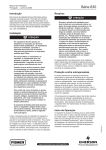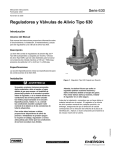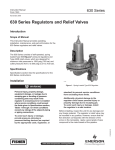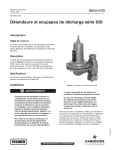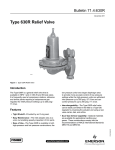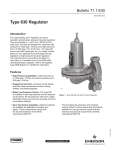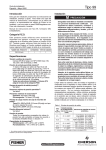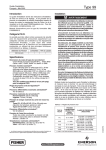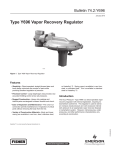Download Emerson 630 Regulator Installation Guide
Transcript
630 Series Installation Guide English – September 2009 This installation guide provides instructions for installation, startup, and adjustment. To receive a copy of the instruction manual, contact your local Sales Office or view a copy at www.emersonprocess.com/ regulators. For further information refer to: 630 Series Instruction Manual, form 1243, D100300X012. Clean out all pipelines before installation of the regulator and check to be sure the regulator has not been damaged or has collected foreign material during shipping. For NPT bodies, apply pipe compound to the external pipe threads. Install the regulator in any position desired, unless otherwise specified, but be sure flow through the body is in the direction indicated by the arrow on the body. Installation Vents ! Warning Only qualified personnel should install or service a regulator. Regulators should be installed, operated, and maintained in accordance with international and applicable codes and regulations, and Emerson Process Management Regulator Technologies, Inc. instructions. If the regulator vents fluid or a leak develops in the system, it indicates that service is required. Failure to take the regulator out of service immediately may create a hazardous condition. Personal injury, equipment damage, or leakage due to escaping fluid or bursting of pressure-containing parts may result if this regulator is overpressured or is installed where service conditions could exceed the limits given in the Specifications section, or where conditions exceed any ratings of the adjacent piping or piping connections. To avoid such injury or damage, provide pressure-relieving or pressure-limiting devices (as required by the appropriate code, regulation, or standard) to prevent service conditions from exceeding limits. Additionally, physical damage to the regulator could result in personal injury and property damage due to escaping fluid. To avoid such injury and damage, install the regulator in a safe location. ! Warning When the unit is installed in an enclosed area or indoors, escaping gas may accumulate and be an explosion hazard. Under these conditions the vent should be piped away from the unit to a freely ventilated outdoor location away from air intakes, windows, etc. Protect all vent openings against weather or the entrance of any foreign material that may plug the vent or affect operation of the regulator or relief valve. Inspect all vent openings periodically to be sure they are not plugged. If the vent is in an environment where freezing rain, ice, or snow could clog the vent, it is recommended that a weatherproof vent be used. Spring-loaded constructions have a screened vent assembly (key 27) installed in the 1/4 NPT spring case vent opening. If a remote vent is required, remove the vent assembly and install a remote vent line. Overpressure Protection The recommended pressure limitations are stamped on the regulator nameplate. Some type of overpressure protection is needed if the actual inlet pressure exceeds the maximum operating outlet pressure rating. Overpressure protection should also be provided if the regulator inlet pressure is greater than the safe working pressure of the downstream equipment. www.emersonprocess.com/regulators D100300XUS2 Introduction 630 Series Specifications Available Configurations Type 630: Spring-loaded reducing regulators Type 630R: Spring-loaded relief valves Maximum Allowable Outlet Pressures(1) See Table 2 Maximum Allowable Pressure Drops(1) See Table 1 Body Size and End Connection Style 1 or 2 NPT Temperature Capabilities(1) Standard: -20° to 150°F (-29° to 66°C) Optional: -20° to 300°F (-29° to 149°C) Maximum Allowable Inlet Pressures Type 630 Regulators: See Table 1 Type 630R Relief Valves: See Table 3 (1) Outlet Pressure Ranges(1) 3 to 500 psig (0,21 to 34,5 bar) with intermediate values shown in Table 2 Orifice Sizes 1/8-inch (3,2 mm), 3/16-inch (4,8 mm), 1/4-inch (6,4 mm), 3/8-inch (9,5 mm), or 1/2-inch (13 mm) 1. The pressure/temperature limits in this installation guide or any applicable standard limitation should not be exceeded. Table 1. Maximum Allowable Inlet Pressures and Pressure Drops. Maximum inlet pressure not to exceed 1500 psig (103 bar). Orifice Size, inchES (mm) DISK MATERIAL 1/8 and 3/16 (3,2 and 4,8) 1/4 (6,4) 3/8 (9,5) 1/2 (13) Nylon (PA) and Polytetrafluoroethylene (PTFE) Nitrile(2) (NBR) Fluorocarbon (FKM) 1500 (103) 600 (41,4) 200 (13,8) 1000 (69) 600 (41,4) 200 (13,8) 500 (34,5) 500 (34,5) 200 (13,8) 250 (17,2) 250 (17,2) 200 (13,8) Maximum Allowable Inlet Pressure, Psig (bar) 1500 (103)(1) 1500 (103)(1) 1000 (68,9)(1) 750 (51,8)(1) 1. Inlet pressure must not exceed the sum of the actual outlet pressure setting and the maximum allowable pressure drop. For example, with an outlet pressure setting of 200 psig (13,8 bar) and a 3/8-inch (9,5 mm) orifice with a maximum allowable pressure drop of 500 psi (34,5 bar, differential), the maximum allowable inlet pressure is 700 psig (48,3 bar). 2. Nitrile (NBR) valve disks are normally furnished for pressure drops to 200 psi (13,8 bar, differential). For better erosion resistance, Nylon (PA) valve disks are normally furnished for higher pressure drops. Some erosion of valve disks occurs at all pressure drops due to solid particles in the flow stream. The rate of erosion is higher with large amounts of impurities in the flow stream and with high-pressure drops. Valve disks and other regulator parts must be inspected periodically for erosion and damage and must be replaced as necessary. Table 2. Maximum Outlet Pressures Regulator construction Low-Pressure High-Pressure Outlet Pressure Range, Psig (bar) SPRING Part Number MAXIMUM OPERATING OUTLET PRESSURE, PSIG (bar) Maximum Outlet Pressure Over SETPOINT(1), Psig (bar) 3 to 10 (0,21 to 0,69) 0W019227022 10 (0,69) 8 to 20 (0,55 to 1,4) 0W019127022 20 (1,4) 17 to 30 (1,2 to 2,1) 0W019027022 30 (2,1) 20(2) (1,4) 27 to 40 (1,9 to 2,8) 0Y0664000A2 40 (2,8) Limited by Maximum Emergency Outlet Pressure 27 to 50 46 to 95 90 to 150 150 to 200 200 to 275 (1,9 to 3,5) (3,2 to 6,6) (6,2 to 10,3) (10,3 to 13,8) (13,8 to 19,0) 0W019227022 0W019127022 0W019027022 0Y0664000A2 1J146927142 50 95 150 200 275 (3,5) (6,6) (10,3) (13,8) (19,0) 275 to 500 (19,0 to 34,5) 1K370927082 500 (34,5) Maximum Emergency Outlet (Casing) Pressure(4), psig (bar) 20 (1,4) 200 (13,8) 45 (3,1) 550 (37,9) 200(3) (13,8) 1. Damage to internal parts of the regulator may occur if outlet pressure exceeds the actual pressure setting by amounts greater than those shown in this column. 2. For outlet pressure settings to 25 psig (1,7 bar) only. For pressure settings over 25 psig (1,7 bar), outlet pressure is limited by maximum emergency outlet pressure of 45 psig (3,1 bar). 3. For outlet pressure settings to 350 psig (24,2 bar) only. For pressure settings over 350 psig (24,2 bar), outlet pressure is limited by maximum emergency outlet pressure of 550 psig (37,9 bar). 4. Leakage or bursting of pressure containing parts may occur if outlet pressure exceeds these values. 2 630 Series 0X00119-F Figure 1. Spring-Loaded Type 630 Regulator - Low-Pressure Construction Table 3. Outlet Pressure Ranges Regulator construction Relief (inlet) Pressure Settings, Psig (bar) Part Number Maximum Allowable Relief (Inlet) Pressure, psig (bar) Maximum Emergency INlet (casing) Pressure(1), Psig (bar) Low-Pressure 3 to 8 6 to 17 15 to 22 20 to 35 27 to 50 (0,21 to 0,55) (0,41 to 1,1) (1,0 to 1,5) (1,4 to 2,4) (1,9 to 3,5) 0W019227022 0W019127022 0W019027022 0Y066427022 1J146927142 Relief Pressure Setting Plus Maximum Allowable Build-up of 25 psig (1,7 bar) 75 (5,2) High-Pressure 30 to 70 50 to 95 75 to 175 150 to 250 (2,0 to 4,8) (3,5 to 6,5) (5,2 to 12,1) (10,4 to 17,3) 0W019127022 0W019027022 0Y066427022 1J146927142 Relief Pressure Setting Plus Maximum Allowable Build-up of 250 psig (17 bar) 550 (38,0) 1. Leakage or bursting of pressure-containing parts may occur if inlet pressure exceeds these values. Regular operation below the maximum pressure limitations does not preclude the possibility of damage from external sources or debris in the line. The regulator should be inspected for damage after any overpressure condition. Startup The regulator is factory set at approximately the midpoint of the spring range or the pressure requested, so an initial adjustment may be required to give the desired results. With proper installation completed and relief valves properly adjusted, slowly open the upstream and downstream shutoff valves. Adjustment To change the outlet pressure, remove the closing cap or loosen the locknut and turn the adjusting screw clockwise to increase outlet pressure or counterclockwise to decrease pressure. Monitor the outlet pressure with a test gauge during the adjustment. Replace the closing cap or tighten the locknut to maintain the desired setting. Taking Out of Service (Shutdown) ! Warning To avoid personal injury resulting from sudden release of pressure, isolate the regulator from all pressure before attempting disassembly. 3 630 Series Parts List Key Description 1 2 3 4 5 6 7 8 9 10 11 12 13 14 15 16 17 18 19 20 21 21 22 23 27 31 32 33 34 35 36 37 52 53 Adjusting Screw Hex Nut Spring Case Upper Spring Seat Spring Cap Screw Lower Spring Seat Diaphragm Plate Cap Screw Cap Screw Diaphragm Connector Head Assembly Diaphragm Adaptor Lever Assembly Pin Gasket Cap Screw Inlet Adaptor Inlet Body Gasket (2 required) Orifice Valve Disk Assembly Type 630 only O-Ring Holder (Type 630R only) Valve Carrier Body Vent Assembly, Type Y602-12 Cap Screw (2 required) (not shown) O-Ring Washer (Type 630R only) Plug (not shown) Nameplate Drive Screw (4 required) Machine Screw (Type 630R only) O-Ring (Type 630R only) NACE Tag (not shown) Tag Wire (not shown) CB2197-E Figure 2. Spring Loaded Type 630 Regulator High-Pressure Construction CD3355-E Figure 3. Spring-Loaded Type 630R Relief Valve High-Pressure Construction Industrial Regulators Natural Gas Technologies TESCOM Emerson Process Management Regulator Technologies, Inc. Emerson Process Management Regulator Technologies, Inc. Emerson Process Management Tescom Corporation USA - Headquarters McKinney, Texas 75069-1872 USA Tel: 1-800-558-5853 Outside U.S. 1-972-548-3574 USA - Headquarters McKinney, Texas 75069-1872 USA Tel: 1-800-558-5853 Outside U.S. 1-972-548-3574 USA - Headquarters Elk River, Minnesota 55330-2445 USA Tel: 1-763-241-3238 Asia-Pacific Shanghai, China 201206 Tel: +86 21 2892 9000 Asia-Pacific Singapore, Singapore 128461 Tel: +65 6777 8211 Europe Bologna, Italy 40013 Tel: +39 051 4190611 Europe Bologna, Italy 40013 Tel: +39 051 4190611 Gallardon, France 28320 Tel: +33 (0)2 37 33 47 00 Middle East and Africa Dubai, United Arab Emirates Tel: +971 4811 8100 Europe Selmsdorf, Germany 23923 Tel: +49 (0) 38823 31 0 For further information visit www.emersonprocess.com/regulators The Emerson logo is a trademark and service mark of Emerson Electric Co. All other marks are the property of their prospective owners. Fisher is a mark owned by Fisher Controls, Inc., a business of Emerson Process Management. The contents of this publication are presented for informational purposes only, and while every effort has been made to ensure their accuracy, they are not to be construed as warranties or guarantees, express or implied, regarding the products or services described herein or their use or applicability. We reserve the right to modify or improve the designs or specifications of such products at any time without notice. Emerson Process Management does not assume responsibility for the selection, use or maintenance of any product. Responsibility for proper selection, use and maintenance of any Emerson Process Management product remains solely with the purchaser. ©Emerson Process Management Regulator Technologies, Inc., 2005, 2009; All Rights Reserved




